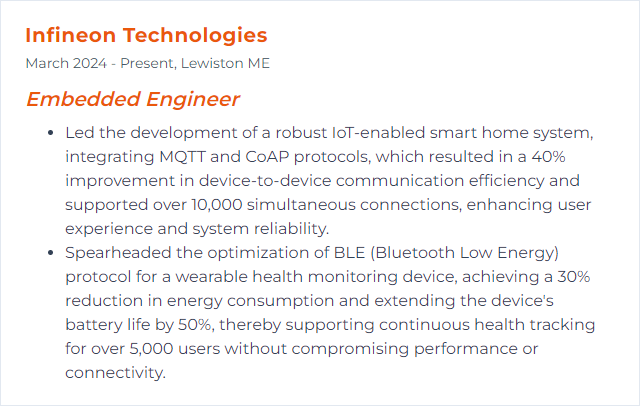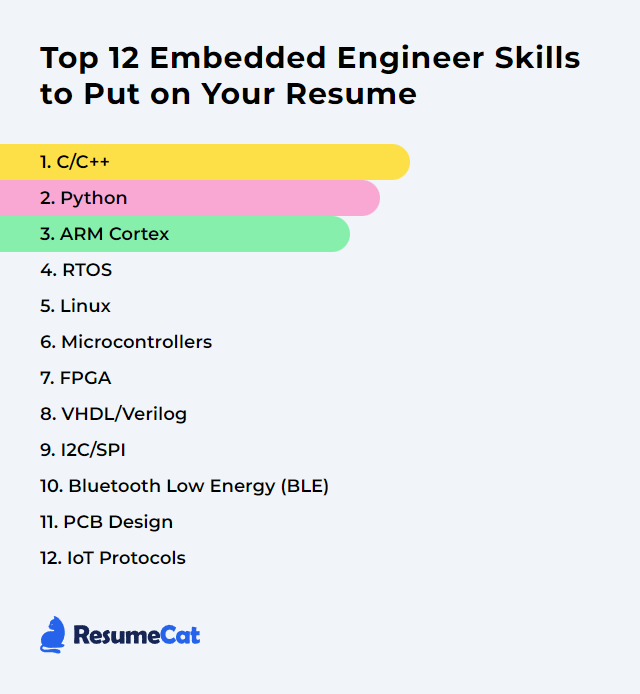Top 12 Embedded Engineer Skills to Put on Your Resume
In today’s rapidly shifting tech world, embedded engineers are hotly sought after. Hiring managers skim fast. Strong resumes punch hard with skills that matter, not fluff. Put your sharpest embedded engineering strengths up front and let the details prove you can build, debug, and deliver under tight constraints.
Embedded Engineer Skills
- C/C++
- Python
- ARM Cortex
- RTOS
- Linux
- Microcontrollers
- FPGA
- VHDL/Verilog
- I2C/SPI
- Bluetooth Low Energy (BLE)
- PCB Design
- IoT Protocols
1. C/C++
C and C++ remain the backbone of embedded development. They grant tight control of memory, direct access to hardware, and the speed you need when deadlines are measured in microseconds.
Why It's Important
C/C++ let embedded engineers write deterministic, lean code that talks to registers, manages limited RAM, and meets real-time demands without breaking a sweat.
How to Improve C/C++ Skills
Blend theory with hands-on practice and keep iterating.
Nail the fundamentals: Pointers, memory layout, bitwise ops, data structures, undefined behavior. Know them cold.
Think at the metal: Map peripherals, read datasheets, understand linker scripts, startup code, and how interrupts really flow.
Practice relentlessly: Small drivers, circular buffers, ring queues, custom allocators, finite state machines. Build, break, fix.
Read good code: Study battle-tested libraries and real firmware. Notice patterns, error handling, and how portability is achieved.
Go deeper: Concurrency, lock-free structures (when appropriate), memory models, real-time constraints, and timing analysis.
Use modern C++ carefully: Embrace RAII, constexpr, enum class, and templates where they reduce bugs or overhead. Avoid heap churn on constrained targets.
Project work: Ship small embedded projects end to end. Sensor in, compute, control out. Measure, profile, optimize.
Iterate quality: Code reviews, refactors, static analysis, and strict warnings-as-errors builds.
Stay in the conversation: Communities and forums focused on embedded C/C++ can spark solutions and reveal pitfalls early.
How to Display C/C++ Skills on Your Resume

2. Python
Python is the quick-draw tool for scripts, automation, data wrangling, and test harnesses. In embedded work, it shines for rapid prototyping, lab tooling, and glue code.
Why It's Important
Python accelerates validation and integration. Faster bring-up. Cleaner test pipelines. Easier data analysis for sensor-heavy systems and IoT gateways.
How to Improve Python Skills
Solid basics: Iterables, generators, context managers, packaging, venvs. Keep code tidy and readable.
Embedded flavors: Explore MicroPython/CircuitPython and constraints of tiny interpreters.
Profile and optimize: Identify hotspots, trim allocations, and avoid needless copies. Measure before you tweak.
Talk to hardware: Build scripts for GPIO, I2C/SPI via bridges, serial tools, and test automation for boards on your bench.
Concurrency: Threads, processes, and async where appropriate. Bound I/O waits. Keep timing predictable.
Essential libraries: Logging, argparse, pathlib, csv/json, PySerial (for UART), and pytest for tests.
Ship tools: Create small CLIs that your team actually uses. Package them. Document briefly. Maintain.
How to Display Python Skills on Your Resume
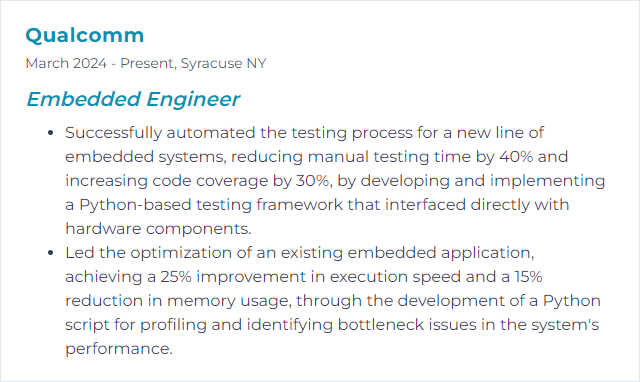
3. ARM Cortex
Arm Cortex is a family of 32-bit and 64-bit RISC cores spanning Cortex-M (microcontrollers), Cortex-R (real-time), and Cortex-A (application processors). Efficient, scalable, everywhere.
Why It's Important
Cortex devices hit the sweet spot of performance per watt and ecosystem support. Toolchains, libraries, examples—less friction, more building.
How to Improve ARM Cortex Skills
Know the core: Study the specific Cortex variant, pipeline, exception model, memory protection, and cache behavior.
Power tactics: Use sleep modes, clock gating, and peripheral wakeups. Measure current, don’t guess.
Write tight code: Favor simple branches, avoid heavy abstractions in hot paths, and leverage CMSIS and vendor HALs judiciously.
Compiler savvy: Tune optimization flags for size or speed. Inspect generated assembly for critical routines.
DMA everything: Offload transfers where possible. Free the CPU for control logic or idling.
Profile and debug: Use SWD/JTAG, trace, ITM, and logic analyzers. Verify timing and ISR latency.
RTOS alignment: Balance priorities, stack sizes, and tick settings. Avoid priority inversion and long ISRs.
Use accelerators: Crypto engines, DSP instructions, FPU, and NN accelerators when available.
Stay current: Update SDKs and board support to benefit from fixes and silicon errata workarounds.
How to Display ARM Cortex Skills on Your Resume
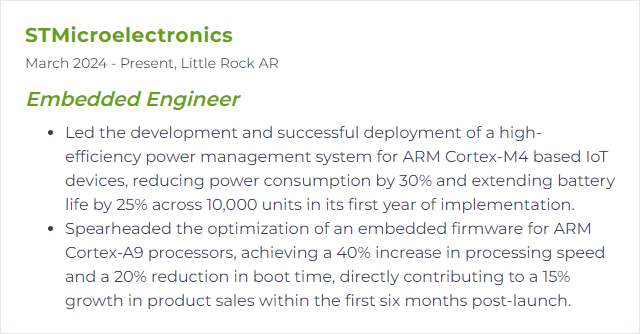
4. RTOS
A Real-Time Operating System coordinates tasks under strict timing, handling scheduling, synchronization, and interrupts so deadlines are met—predictably.
Why It's Important
When timing isn’t a wish but a requirement, an RTOS brings determinism, safer concurrency, and maintainable structure to complex firmware.
How to Improve RTOS Skills
Scheduling strategy: Choose and configure policies (fixed-priority, rate monotonic, EDF) that match your workload.
Memory sanity: Right-size stacks, use static allocation where possible, and watch for fragmentation.
Interrupt discipline: Keep ISRs short, defer work to tasks, and set clear priority boundaries.
Locks done right: Mutexes with priority inheritance, semaphores for signaling, queues for data flow. Avoid deadlocks.
Power-aware scheduling: Tickless idle, event-driven wakeups, and measured sleep policies.
Instrumentation: Trace tasks, measure jitter, detect starvation, and catch missed deadlines early.
Tune configurations: Only enable what you need. Trim features to fit flash/RAM budgets.
Test like you mean it: Fault injection, overload tests, and long soak runs to validate worst-case behaviors.
How to Display RTOS Skills on Your Resume
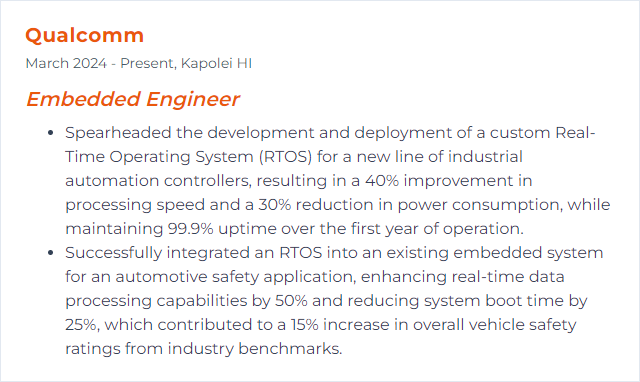
5. Linux
Linux is the open-source kernel powering countless embedded products—from routers to robots. Tailor it, strip it, make it your own.
Why It's Important
Flexibility, stability, and a massive driver ecosystem. For connected, complex devices, Linux shortens paths to robust features.
How to Improve Linux Skills
Right-size the system: Use Buildroot or Yocto Project to craft minimal images that fit your hardware like a glove.
Security first: Secure Boot, signed updates, least-privilege services, and MAC frameworks like SELinux or AppArmor.
Reliability: Watchdog coverage, resilient filesystems (UBIFS, ext4 with journaling), and safe-update strategies with rollback.
Tooling: gdbserver, strace, perf, ftrace, and eBPF for visibility when bugs hide deep.
Real-time needs: PREEMPT_RT or dual-kernel strategies when worst-case latency matters.
Contribute and learn: Follow kernel changes, read commit messages, and understand subsystem maintainers’ expectations.
How to Display Linux Skills on Your Resume
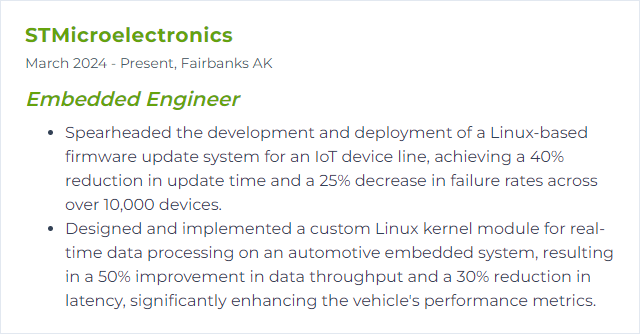
6. Microcontrollers
Microcontrollers cram a CPU, memory, and peripherals into a single chip that runs the show. Tiny, frugal, relentless.
Why It's Important
They are the control heart of embedded systems—cost-effective, versatile, and dependable across countless use cases.
How to Improve Microcontrollers Skills
Power mastery: Sleep states, clock scaling, peripheral gating, and measured current budgets.
Efficient code: Optimize for size and speed, enable compiler warnings, and profile critical loops.
Firmware hygiene: Keep SDKs updated, track errata, and apply vendor-recommended fixes.
Peripheral savvy: Configure timers, ADCs, UART/I2C/SPI, PWM, and DMA with intention. Don’t guess defaults.
Communication robustness: CRCs, retries, timeouts, and graceful recovery paths.
Interrupt best practices: Prioritize carefully, keep handlers short, and protect shared data.
Debug and profile: Use logic analyzers, oscilloscopes, and on-chip debug features to pinpoint bottlenecks.
Modular design: Clear HAL layers, testable drivers, and interfaces that scale with changing requirements.
How to Display Microcontrollers Skills on Your Resume
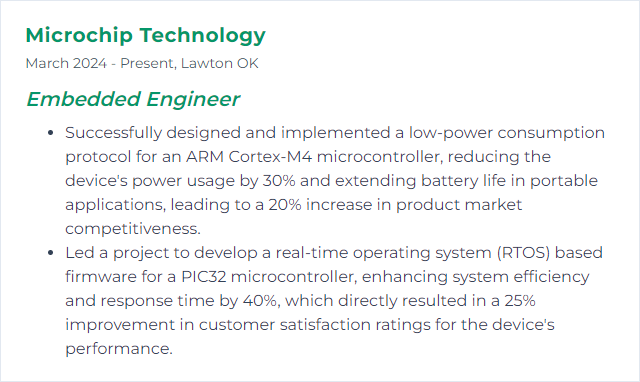
7. FPGA
FPGAs are reconfigurable hardware. Software-like flexibility with hardware-grade performance when CPUs stall.
Why It's Important
They enable parallelism, low latency paths, and custom accelerators—powerful for signal processing, control, and high-throughput pipelines.
How to Improve FPGA Skills
Lean HDL: Write clear, synchronous designs. Minimize logic depth and keep clock domains disciplined.
Use resources smartly: DSP slices, BRAMs, LUTRAM, and SERDES—map algorithms to the right blocks.
Exploit parallelism: Dataflow architectures, concurrent kernels, and carefully staged pipelines.
Pipelining: Break long paths; balance stages; watch throughput and latency tradeoffs.
Clocking: Clean PLL/MMCM usage, clock enables over gates, and tight constraints for skew control.
Power awareness: Prune toggling, clock-gate thoughtfully, and select lower-voltage options when viable.
Simulate early: Unit-test modules, run timing sims, and add assertions to catch corner cases.
HLS where it fits: High-Level Synthesis can speed iteration; validate results and inspect generated RTL.
How to Display FPGA Skills on Your Resume
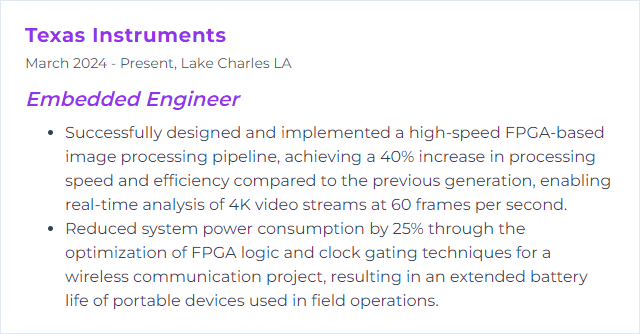
8. VHDL/Verilog
VHDL and Verilog describe, simulate, and verify digital logic—from modules on FPGAs to blocks destined for ASICs. Precise behavior, clock by clock.
Why It's Important
They let you architect reliable hardware, reason about timing, and prove designs before they ever see silicon.
How to Improve VHDL/Verilog Skills
Core concepts: Combinational vs sequential logic, clock enables, resets, and CDC strategies.
Practice modules: FIFOs, arbiters, serializers, DSP blocks, AXI/AHB interfaces—build and test.
Reviews: Read other engineers’ RTL. Learn idioms, naming, and reset conventions.
Simulation forward: Create robust testbenches, assertions, coverage, and randomized tests.
Debug habits: Waveform literacy, signal naming discipline, and incremental bring-up.
Style and reuse: Parameterize wisely; keep modules cohesive; document timing expectations.
Verification skills: Step into UVM or lightweight verification patterns as designs scale.
Timing closure: Constrain well, floorplan when needed, and iterate until slack is honest and stable.
How to Display VHDL/Verilog Skills on Your Resume

9. I2C/SPI
I2C and SPI connect microcontrollers to sensors, memories, displays, and more. Simple wiring, reliable transfers, broad support.
I2C: Two wires (SDA, SCL), multi-master capable, half-duplex. Great for moderate speed and many devices.
SPI: Four wires (SCK, MOSI, MISO, CS), single master, full-duplex. High speed, low overhead.
Why It's Important
These buses are the lingua franca of peripherals. Master them and your hardware talks cleanly with minimal pins and fuss.
How to Improve I2C/SPI Skills
I2C Improvement
Pull-ups tuned: Choose resistor values based on bus capacitance and target speed. Faster needs stronger pull-ups; watch current draw.
Right speed mode: Standard, Fast, Fast-Plus. Validate signal integrity on a scope before cranking it up.
No address clashes: Map device addresses early; use multiplexers or translators if necessary.
Resilient software: Timeouts, bus recovery on lockups, repeated starts, and DMA when the MCU supports it.
SPI Improvement
Clock edge and polarity: Match CPOL/CPHA exactly; inconsistent modes lead to ghost bugs.
Signal integrity: Short traces, solid ground reference, controlled impedance for high speeds, and tidy chip-select routing.
Throughput tactics: Use DMA, double-buffering, and chunked transfers for sustained rates.
Protocol minimization: Compact frames, fewer handshakes, and well-structured commands to cut overhead.
How to Display I2C/SPI Skills on Your Resume
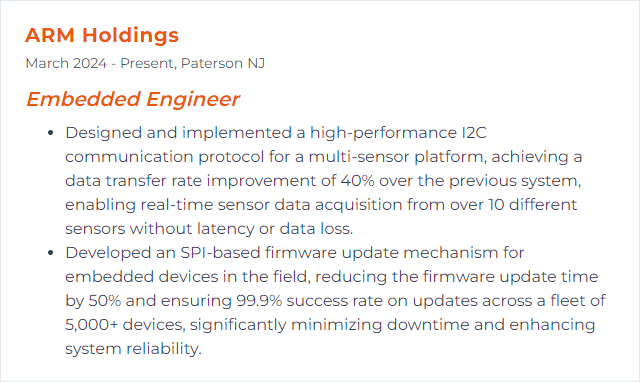
10. Bluetooth Low Energy (BLE)
BLE delivers short-range wireless with miserly power usage. Perfect for wearables, sensors, trackers, and gadgets that must sip battery.
Why It's Important
Interoperability with phones and tablets, low energy profiles, and a mature ecosystem give BLE a huge footprint in consumer and industrial IoT.
How to Improve Bluetooth Low Energy (BLE) Skills
Power tuning: Adjust advertising and connection intervals, use sleep modes, and minimize wakeups.
Throughput within limits: Optimize MTU, data length extension, and connection parameters. Measure real-world rates, not just specs.
Stable links: Retry logic, backoff strategies, and parameter updates to reduce disconnects in noisy environments.
Interference handling: Lean on adaptive frequency hopping and channel maps when the 2.4 GHz band gets crowded.
Security: Use modern pairing methods, bonding, and strong encryption. Keep stacks and firmware updated.
API discipline: Know your stack’s callbacks, buffer lifetimes, and event sequencing to avoid race conditions.
OTA updates: Provide a robust, fail-safe path for field updates.
How to Display Bluetooth Low Energy (BLE) Skills on Your Resume

11. PCB Design
PCB design turns schematics into manufacturable boards that behave in the real, noisy world. Layout is where performance, reliability, and cost collide.
Why It's Important
Good layout protects signal integrity, tames EMI, and ensures robust power delivery—so the firmware you wrote actually sings on hardware.
How to Improve PCB Design Skills
Placement first: Start with power, clocks, high-speed parts, and connectors. Short critical paths. Tight loops. Logical flow.
Power integrity: Solid planes, proper decoupling close to pins, and low-impedance return paths.
Signal integrity: Controlled impedance for fast lines, matched lengths for differential pairs, clean reference planes.
EMC-aware routing: Minimize loop areas, avoid stubs, keep noisy nets away from board edges, and tame return paths.
DFM/DFT: Respect manufacturer capabilities, add test points, and design with assembly in mind.
EDA proficiency: Use rules, constraints, 3D clearance checks, and simulations where they add confidence.
Review and prototype: Peer reviews, checklist passes, and early prototypes to catch what screens don’t.
How to Display PCB Design Skills on Your Resume
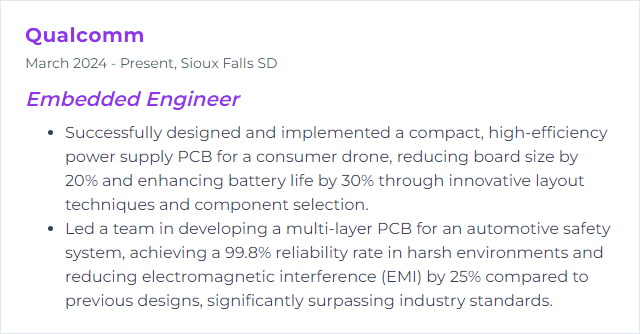
12. IoT Protocols
IoT protocols define how devices exchange data—lightweight, secure, and interoperable. Think MQTT or MQTT-SN for messaging, CoAP for constrained web-style interaction, and Zigbee or Z-Wave for low-power mesh networking.
Why It's Important
The right protocol keeps traffic efficient, batteries happy, and systems talking cleanly across vendors and networks.
How to Improve IoT Protocols Skills
Trim overhead: Prefer compact encodings and payloads that fit the device profile and link budget.
Security baked in: Use modern TLS/DTLS, strong identities, and secure bootstrapping. Rotate keys and plan for revocation.
Interoperability: Follow standards and validate against multiple stacks and brokers. Certification paths help.
Low-power strategies: Duty cycling, observe/notify patterns, and asynchronous designs that let radios sleep more.
Resilience: Retry policies, QoS levels, backpressure handling, and offline buffering to survive flaky links.
How to Display IoT Protocols Skills on Your Resume
